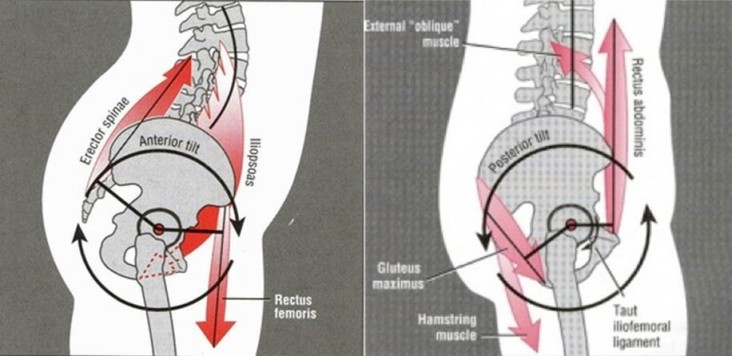We’re excited to share our first three-part series on the blog! There are so many seemingly simple, yet quite complex, our amazing bodies can do. Our team will dive into repetitive motions that you’re doing on the daily to share the why and the how so you can move in a biomechanically sound manner and strengthen your body.
Our first series, the Anatomy of the Squat, is courtesy of Bram van Bommel, our resident Registered Massage Therapist. Check out his second post in the series!
Part 2 – The Roll of the Hip in a Squat
For the body to squat properly, there are a number of actions that must occur:
During the squat our pelvis must do what we call an anterior pelvic tilt. Essentially, this means that our pelvis must tilt forward while we descend in our squat, as shown in the top-left image. At the same time, our hip and lumbar spine must move, or extend backwards. During the squat movement, our hip actually moves into “hip flexion” but the hip is a ball and socket joint so the head of the femur glides in a posterior (towards the butt) direction. For example, if you bring your knee up to your chest you will see that your hip is going into a flexed position but to get into that position the head of our femur had to move backwards.
A common problem that we see is without the proper motor control and mobility of our hips, our lumbar spine (low back) leans forward (as shown in the top-right image) to compensate for the lack of mobility in our hips so that it looks like were getting down to 90 degrees of knee flexion. In this case, our back moves forward and our pelvis goes backward, in turn creating unnecessary pressure on the lower-back. This is called a pelvic wink or posterior pelvic tilt.
To assess your own pelvic wink, stand with your legs shoulders-width apart in front of a door and perform a squat. Your nose must not hit the door. Most people will get to about 50% of the way down and then start to lean forward. The leaning forward shows how much movement is occurring in the hips, and the leaning forward is the body’s way of cheating to get all the way down. However, if you observe carefully the minute your lower-back starts to flex forward, your pelvis doesn’t actually move anymore meaning you are putting excessive force on different aspects of your lower limbs and back.
In the next installment of the series, we’ll get into the mechanics of fixing hip restriction! Did you miss the first post in the series? Check it out here!
Optimal athletic performance drives Registered Massage Therapist Bram van Bommel to work with athletes of all levels to recognize their strengths and weaknesses to pursue programs that proactively prevent sports-related injuries.


